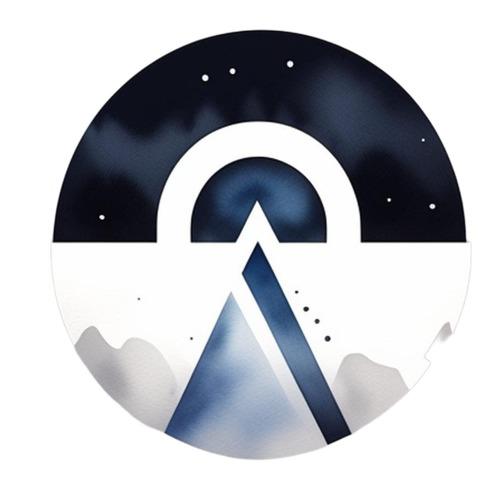
Recurrent and similar myths across various cultures
Many myths from different cultures around the world share strikingly similar themes and motifs, suggesting a universal human imagination and concerns. Here are some recurrent and similar myths across diverse cultures:
1. The Great Flood
One of the most widespread myths is that of a great flood sent by gods to cleanse the earth:
- Mesopotamian Myth: In the Epic of Gilgamesh, the gods send a flood to destroy humanity, but Utnapishtim builds a boat to save his family and animals.
On Amazon - Biblical Story: Noah’s Ark in the Old Testament, where God floods the earth and Noah saves his family and two of every animal species.
On Amazon - Hindu Mythology: Manu is warned by a fish (an avatar of Vishnu) about a great deluge and builds a boat to save himself and the Saptarishi (seven sages).
On Amazon - Greek Mythology: Deucalion and Pyrrha survive a flood sent by Zeus to punish humanity, later repopulating the earth by throwing stones over their shoulders which turn into people.
On Amazon
A collage section showing a boat amidst stormy waves with figures saving animals. Each section of the boat represents different cultures, with appropriate attire and symbols for Mesopotamian, Biblical, Hindu, and Greek floods.
Prompt:
“A boat divided into four sections amidst stormy waves, each section representing a different flood myth. The Mesopotamian section has figures in ancient Sumerian attire with cuneiform tablets and clay artifacts. The Biblical section shows Noah with animals, dressed in robes with a rainbow overhead. The Hindu section depicts Manu saving the fish Matsya, with traditional Indian attire and Vedic symbols. The Greek section shows Deucalion and Pyrrha with ancient Greek clothing and amphorae. The boat is surrounded by turbulent waters and dark skies, with animals being saved.“
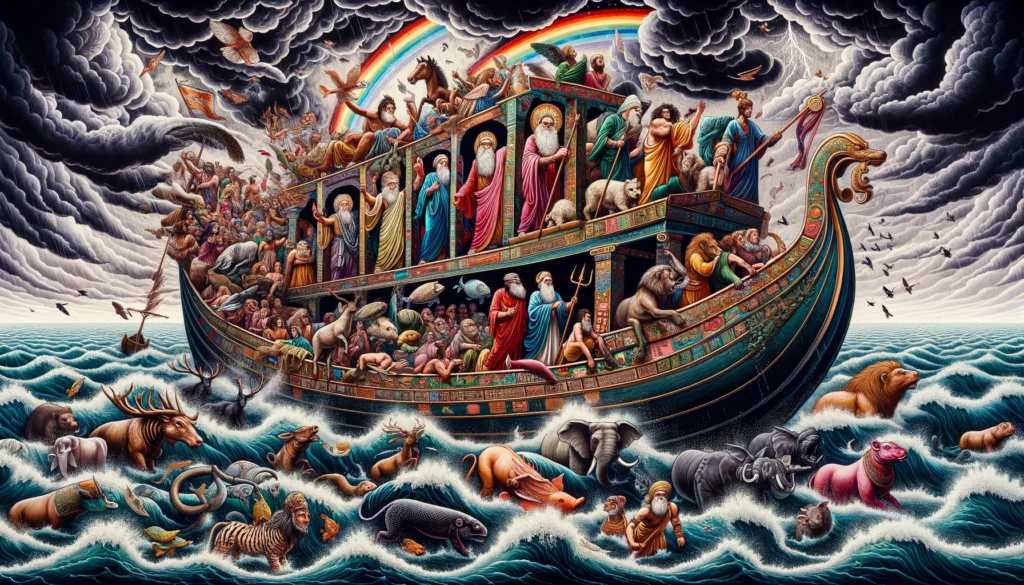
2. Creation Myths
Creation myths explain how the world and humans came into existence, often involving gods or primordial beings:
- Greek Mythology: The world begins from Chaos, followed by the emergence of Gaia (Earth), Uranus (Sky), and other primordial deities.
On Amazon - Norse Mythology: The world is created from the body of the giant Ymir, and humans are created from trees by Odin and his brothers.
On Amazon - Mayan Mythology: The Popol Vuh describes the creation of humans from maize dough by the gods.
on Amazon - Chinese Mythology: Pangu separates the sky from the earth, and his body parts transform into different parts of the natural world upon his death.
On Amazon
A cosmic scene with primordial beings shaping the world, including Greek Chaos and Gaia, Norse Ymir, Mayan gods, and Chinese Pangu.
Prompt:
“A cosmic scene depicting various creation myths. Gaia rises from Chaos, surrounded by stars and cosmic dust. Ymir, a giant figure, with his body parts forming the world. Mayan gods mold humans from maize, with a lush, green background. Pangu, a giant figure, separating the sky and earth with a hammer and chisel. The scene is vibrant and detailed, with elements of each culture intertwined in the creation process.“
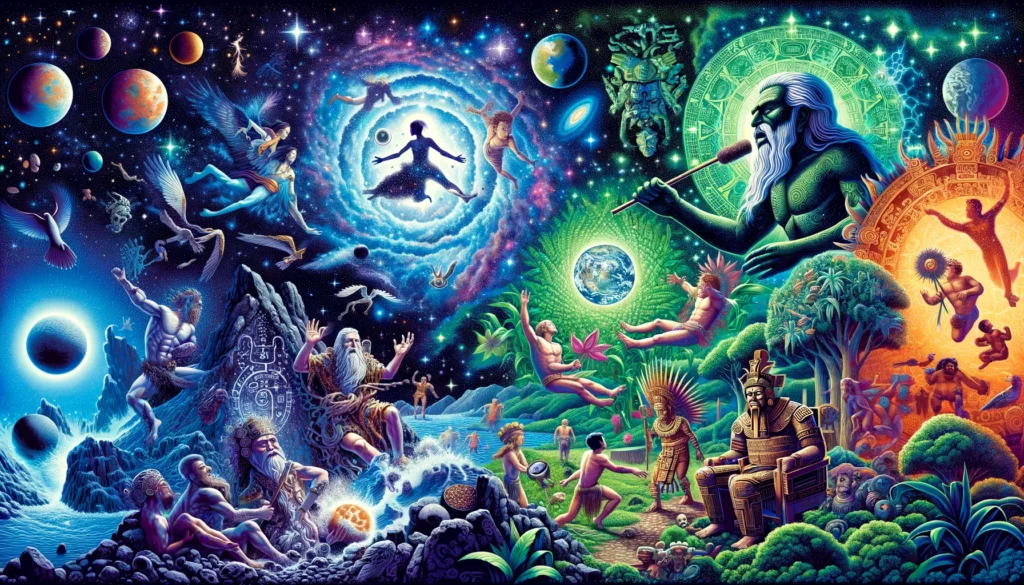
3. Hero’s Journey
A hero embarks on an adventure, faces trials, and returns transformed:
- Greek Mythology: Hercules undertakes 12 Labors as penance and achieves immortality.
On Amazon - Hindu Mythology: Rama in the Ramayana rescues his wife Sita from the demon king Ravana, overcoming numerous obstacles.
On Amazon - Norse Mythology: Sigurd slays the dragon Fafnir and gains wisdom and treasure.
On Amazon - Japanese Mythology: The tale of Momotaro, the Peach Boy, who fights ogres with his animal companions.
On Amazon
Heroes from different cultures battling mythical creatures. Hercules fighting the Nemean lion, Rama in combat with Ravana, Sigurd slaying Fafnir, and Momotaro with his animal companions fighting ogres.
Prompt:
“A collage of heroes battling mythical creatures. Hercules, in ancient Greek attire, fights the Nemean lion with his club. Rama, in traditional Indian attire, battles the multi-headed demon Ravana with a bow and arrow. Sigurd, in Norse warrior gear, slays the dragon Fafnir with a sword. Momotaro, a Japanese hero, fights ogres alongside his animal companions – a dog, a monkey, and a pheasant. The background blends these scenes into a dynamic and vibrant battle.“
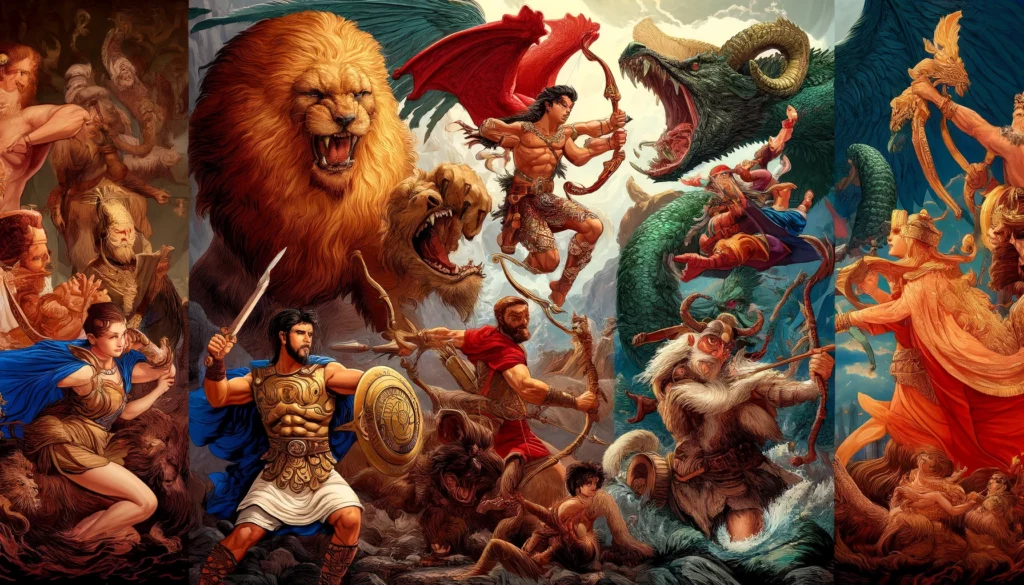
4. Underworld Journeys
Descent into the underworld or a realm of the dead:
- Greek Mythology: Orpheus descends to Hades to retrieve his wife Eurydice.
On Amazon - Sumerian Mythology: Inanna’s Descent into the Underworld to confront her sister Ereshkigal.
on Amazon - Egyptian Mythology: The journey of the dead through the Duat to achieve afterlife, as depicted in the Book of the Dead.
On Amazon - Mesoamerican Mythology: The Hero Twins, Hunahpu and Xbalanque, descend into Xibalba in the Popol Vuh.
on Amazon
Figures descending into dark, mysterious realms, featuring Orpheus, Inanna, Egyptian journey through the Duat, and Mesoamerican Hero Twins.
Prompt:
“A dark and mysterious scene showing various underworld journeys. Orpheus, with his lyre, descends into the underworld. Inanna confronts Ereshkigal in the Sumerian underworld, adorned in regal attire. An Egyptian soul navigates the Duat, with hieroglyphics and ancient Egyptian symbols. The Mesoamerican Hero Twins, armed with blowguns, face trials in Xibalba. The scene is shadowy and mystical, with elements of each culture’s depiction of the underworld.“
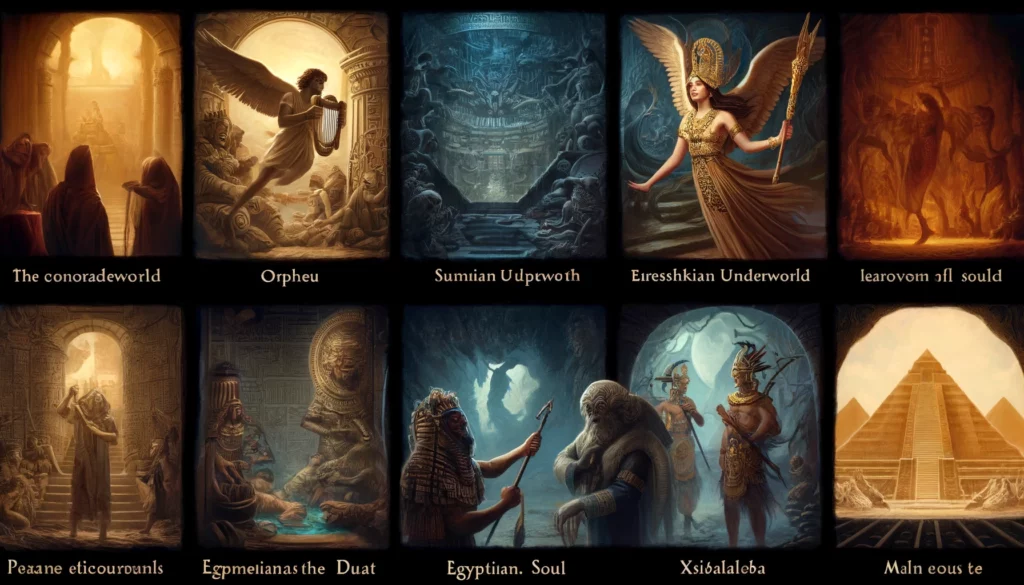
5. Trickster Figures
Tricksters are cunning beings who defy norms and conventions:
- African Mythology: Anansi the spider uses his wit to outsmart stronger creatures.
On Amazon - Norse Mythology: Loki, a shape-shifting god, causes trouble and occasionally aids the gods.
On Amazon - Native American Mythology: Coyote, who alternates between foolishness and cleverness, influencing the world’s creation.
on Amazon - Japanese Mythology: The kitsune, or fox, is a shapeshifter that can be both a trickster and a benefactor.
On Amazon
Clever and mischievous beings, including African Anansi, Norse Loki, Native American Coyote, and Japanese Kitsune.
Prompt:
“A vibrant scene featuring trickster figures from various cultures. Anansi, a spider, spins his web with a mischievous grin. Loki, shape-shifting, surrounded by illusions. Coyote, with a playful expression, holding a trickster’s staff. Kitsune, in fox form and human form, with foxfire and a magical aura. Each figure is depicted with cultural symbols and attire, creating a lively and mischievous atmosphere.“
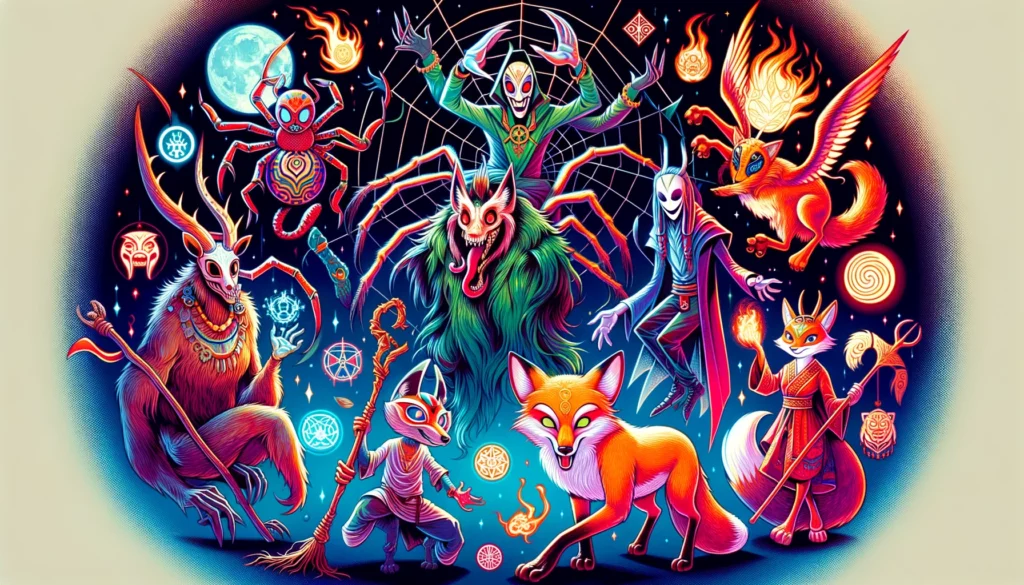
6. End of the World
Many cultures have myths about the end of the world, often involving cycles of destruction and renewal:
- Norse Mythology: Ragnarok, the prophesied end where gods and giants clash, leading to the rebirth of the world.
On Amazon - Hindu Mythology: The end of the Kali Yuga, after which the world will be renewed by Vishnu’s Kalki avatar.
On Amazon - Mayan Mythology: Cyclical destruction and creation, with the current world being the fifth creation.
On Amazon - Christian Eschatology: The Book of Revelation describes the final judgment and the creation of a new heaven and earth.
On Amazon
Apocalyptic scenes with rebirth, featuring Norse Ragnarok, Hindu end of Kali Yuga, Mayan cyclical destruction, and Christian Revelation.
Prompt:
“An apocalyptic scene with elements of rebirth from different cultures. The battle of Ragnarok, with flames and a giant serpent, and figures emerging from the destruction. The Hindu Kalki avatar on a white horse, wielding a sword, amidst a chaotic backdrop. Mayan gods creating a new world after destruction, with intricate Mayan architecture. Angels with trumpets and heavenly light from the Christian Revelation. The scene is dramatic and intense, with a sense of renewal.“
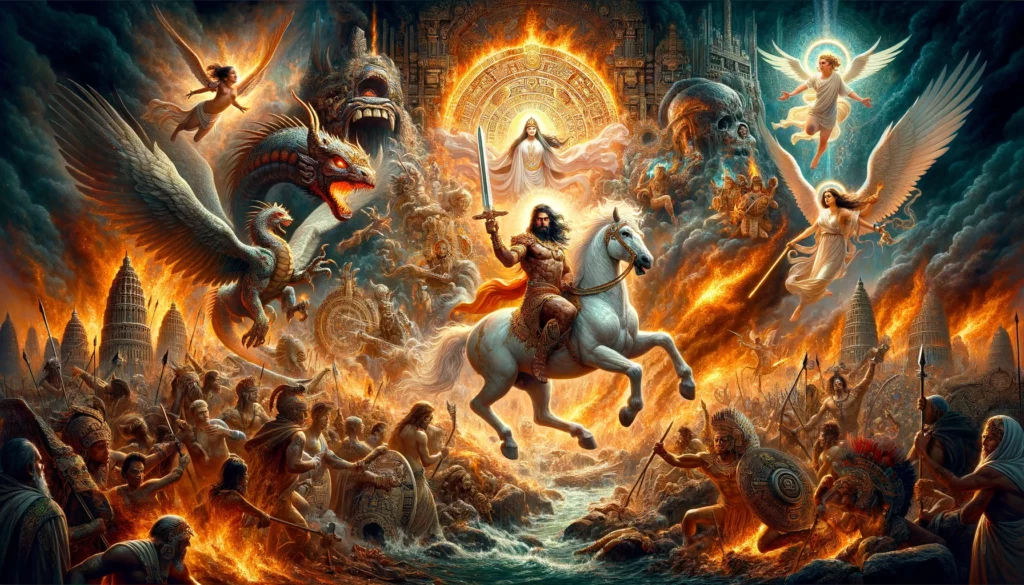
7. Sun and Moon
The myths surrounding the celestial bodies often involve their origins, battles, or roles in the cosmos:
- Egyptian Mythology: Ra, the sun god, travels through the underworld every night to be reborn at dawn.
On Amazon - Japanese Mythology: Amaterasu, the sun goddess, retreats into a cave causing darkness, and is lured out to restore light.
On Amazon - Incan Mythology: Inti, the sun god, is central to Incan worship, and the moon goddess Mama Killa regulates time and menstruation.
on Amazon - Chinese Mythology: The legend of Houyi shooting down nine of ten suns to save the earth from scorching heat.
On Amazon
Sun and moon fictive art galleries
Celestial figures and events, featuring Egyptian Ra, Japanese Amaterasu, Incan Inti and Mama Killa, and Chinese Houyi shooting down suns.
Prompt:
“A celestial scene depicting sun and moon myths. Ra, in a solar barque, sails across the sky with the sun disk. Amaterasu, emerging from a cave, bringing light to the world. Inti, shining brightly, with Mama Killa, the moon goddess, beside him. Houyi, an archer, aiming his bow at multiple suns in the sky. The background is filled with celestial motifs and vibrant colors, capturing the essence of these myths.“
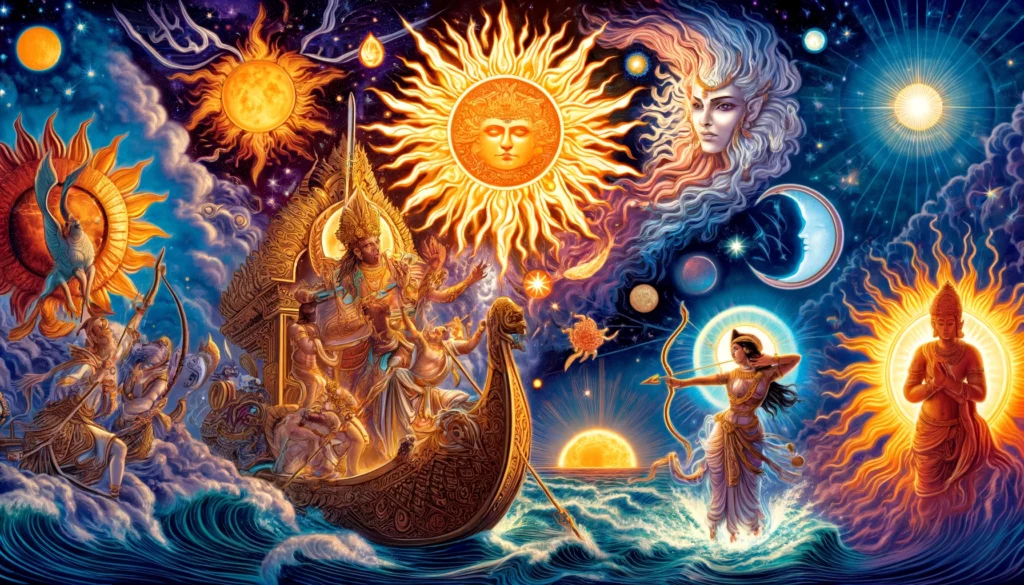
Conclusion
These recurring themes suggest that different cultures, despite their geographic and historical distances, grapple with similar existential questions and experiences. The shared motifs highlight a collective human experience and imagination, bridging cultural gaps and enriching our understanding of humanity’s diverse yet connected heritage.
Resumed in a table
Table summarizing the recurrent and similar myths across various cultures:
| Myth Theme | Culture/Example | Description |
| The Great Flood | Mesopotamian: Epic of Gilgamesh | Utnapishtim builds a boat to save his family and animals from a god-sent flood. |
| Biblical: Noah’s Ark | Noah builds an ark to save his family and animals from a god-sent flood. | |
| Hindu: Manu and the fish | Manu is warned of a flood and builds a boat to save himself and sages. | |
| Greek: Deucalion and Pyrrha | Deucalion and Pyrrha survive a flood sent by Zeus and repopulate the earth. | |
| Creation Myths | Greek: Chaos and Gaia | The world begins from Chaos, with Gaia (Earth) and Uranus (Sky) emerging. |
| Norse: Ymir and the gods | The world is created from the body of the giant Ymir. | |
| Mayan: Popol Vuh | Humans are created from maize dough by gods. | |
| Chinese: Pangu | Pangu separates the sky from the earth; his body parts transform into natural elements. | |
| Hero’s Journey | Greek: Hercules | Undertakes 12 Labors as penance and achieves immortality. |
| Hindu: Rama in the Ramayana | Rescues his wife Sita from the demon king Ravana. | |
| Norse: Sigurd | Slays the dragon Fafnir and gains wisdom and treasure. | |
| Japanese: Momotaro, the Peach Boy | Fights ogres with his animal companions. | |
| Underworld Journeys | Greek: Orpheus | Descends to Hades to retrieve his wife Eurydice. |
| Sumerian: Inanna | Inanna descends into the Underworld to confront her sister Ereshkigal. | |
| Egyptian: Book of the Dead | The dead journey through the Duat to achieve afterlife. | |
| Mesoamerican: Popol Vuh | The Hero Twins descend into Xibalba. | |
| Trickster Figures | African: Anansi the spider | Uses wit to outsmart stronger creatures. |
| Norse: Loki | A shape-shifting god who causes trouble and occasionally aids the gods. | |
| Native American: Coyote | Alternates between foolishness and cleverness, influencing the world’s creation. | |
| Japanese: Kitsune | A shapeshifter that can be both a trickster and a benefactor. | |
| End of the World | Norse: Ragnarok | Prophesied end where gods and giants clash, leading to the rebirth of the world. |
| Hindu: End of the Kali Yuga | The world will be renewed by Vishnu’s Kalki avatar. | |
| Mayan: Cyclical destruction | The current world is the fifth creation following cycles of destruction and renewal. | |
| Christian: Book of Revelation | Describes the final judgment and creation of a new heaven and earth. | |
| Sun and Moon | Egyptian: Ra | The sun god travels through the underworld every night to be reborn at dawn. |
| Japanese: Amaterasu | The sun goddess retreats into a cave causing darkness, and is lured out to restore light. | |
| Incan: Inti and Mama Killa | Inti is central to worship, and Mama Killa regulates time and menstruation. | |
| Chinese: Houyi and the ten suns | Houyi shoots down nine of ten suns to save the earth from scorching heat. |
This table highlights the universal nature of these mythological themes, illustrating their presence across diverse cultures.







Enchanted whisperer GPT
The Enchanting Whisperer GPT unveils myths
with a touch of enchantment and modern relevance.
